Cornered between Belgium, France, and Germany lies the second-smallest member of the European Union, namely, the Grand Duchy of Luxembourg. A constitutional monarchy, it is characterized by a multilingual “personal” policy regimenting the use of four labeled language varieties in distinct domains of the state. Luxembourgish, French, German, and German Sign Language make up the named languages of the state, of which German Sign Language is the latest addition (2018). This personal language policy regiments the use of the four language varieties in the borders of a state whose population is 645,397 (as of January 1, 2022; cf. Klein and Peltier Reference Klein2022), 47 percent of whom are foreign nationals. Furthermore, of the four named language varieties, Luxembourgish, declared “national language” in 1984, is in the midst of a standardization process following renewed language planning efforts since 2018. In this article, I will delve into the enregisterment (Reference AghaAgha 2007, Reference Agha2015) of Luxembourgish as a discursive register and as a voice (Wortham and Reference WorthamReyes 2020, 7) during the nineteenth century, whereby Luxembourgish became a highly disputed emblem of personhood and nationhood in pathways that shape current language policy. The focus is on the simultaneous processes of enregisterment and erasure (from language policy) of Luxembourgish from 1830 to 1896.
Most studies of language policy, standardization, and multilingualism in Luxembourg take either a Bourdieuan sociology approach (Reference FehlenFehlen 2009, Reference Fehlen2011, Reference Fehlen2015, Reference Fehlen2018 Reference Fehlen2019), a historical approach (Péporté et al. Reference Péporté2010), a sociohistorical (Gilles and Reference GillesMoulin 2003), a linguistic (Reference GillesGilles 2000, Reference Gilles2019, Reference Gilles2022), a sociolinguistic (Reference WagnerWagner 2015, Reference Wagner2020; Reference PurschkePurschke 2020, Reference Purschke2021; Entringer et al. Reference Entringer2021), or a language ideological approach (Horner and Reference HornerWeber 2008; Reference HornerHorner 2005; Weber and Reference WeberHorner 2012; Bellamy and Reference BellamyHorner 2019). There is to date no study on standardization and language policy in Luxembourg as enregisterment and metapragmatic discourse, respectively. This article seeks to begin to fill that gap. Such an endeavor requires a reinterpretation of archival data that have been analyzed through the different approaches mentioned above, particularly Fehlen (Reference Fehlen2009, Reference Fehlen2011, Reference Fehlen2015, Reference Fehlen2019). I argue that a linguistic anthropological approach provides a fuller understanding of language policy in Luxembourg by analyzing the cross-event linkages solidifying “pathways” (Wortham and Reference WorthamReyes 2020, 20) in semiotic chains that form various ethnometapragmatics (Reference SilversteinSilverstein 1979; Reference AghaAgha 2007), that is, the typifications of French, German, and Luxembourgish in nineteenth-century Luxembourg.
The analysis is based on policy texts, media texts, and linguistics texts from 1830 to 1896 as archival data. It is complemented by sociohistorical data that situate the enregisterment processes in specific spatiotemporal settings. Archival data illustrated as figures in the article are screenshots taken by the author from legilux.lu and eluxemburgensia.lu. In order to understand the emergence of a Luxembourgish standard as discursive register and voice, the metapragmatic data are analyzed as narrating and narrated events that describe, reproduce, or inflect “semiotic chains,” or, for linguistic signs, “speech-chain networks” (Reference AghaAgha 2007, 67).
Language Policy: A Linguistic Anthropological Standpoint
Following the “characteristic analytic move” (Reference WoolardWoolard 2020, 1) of linguistic anthropology, I subscribe to the definition of ideology as that which mediates between language structure and language use (Reference SilversteinSilverstein 1998, Reference Silverstein2003). In this mediating role, enregisterment is made possible as a social process “whereby diverse behavioral signs (whether linguistic, nonlinguistic, or both) are functionally reanalyzed as cultural models of action, as behaviors capable of indexing characteristics of incumbents of particular interactional roles, and of relations among them” (Reference AghaAgha 2007, 55). When referring to linguistic signs in the process of enregisterment, they are called “registers of discourse,” which are cultural models that link personhood to speech forms. A register can be analyzed through a minimum of three variables: its repertoire, its social range, and its social domain. As Agha (Reference Agha2015, 28) explains succinctly: “It is expressed or made manifest through criterial behaviors (its repertoires), which have stereotypic indexical values (its social range) for persons who recognize or perform such signs in their practices (its social domain).”
Interactants align themselves into roles during interaction by performing social personae (“voice” or “characterological figures” linked to speech forms and semiotic accompaniments) that may be strategically manipulated to get a desired effect. These role alignments may be symmetric or asymmetric—that is, certain interactants may align due to their belonging to the same social domain and their fluency in the register, but a difference in this respect for one of the interactants may lead to asymmetric role alignments. Through role alignment, “footings” among interactants emerge. Moreover, types of people exhibit prototypical behaviors that can be made explicitly stereotypical through typifying utterances that designate roles functioning as “metasigns” of personhood (a judge, a queen, a wizard, a doctor, etc.). These are “lexical role designators” based on role diacritics, that is, “an indexical that functions in interaction to differentiate one social kind of actor from others, or one role from another” (Reference AghaAgha 2007, 248). These contrastive figures are organized by axes of differentiation, that is, contrast sets imbued with cultural value (Reference GalGal 2018, 229–30).
Taking this as a starting point and responding to Pennycook’s (Reference Pennycook2021) call for a “turn” away from interdisciplinarity to “semiotic assemblages,” I define language policy as metapragmatic discourses, generally tied to a collectivity (state, family, school), the effects of which institutionalize linguistic signs into registers by establishing or maintaining “semiotic ranges” (Reference AghaAgha 2007, 22) linked to stereotypic emblems of personhood through ideology. The institutionalization of linguistic signs is founded by semiotic chains that bring about the circulation and reanalysis of the linguistic signs in a dialectic of norm and trope (Reference AghaAgha 2007, 295–98).Footnote 1 This process may sediment into state traditions with their own path dependencies for language policy (Sonntag and Reference SonntagCardinal 2015). Put plainly, language policy is the effect of utterances that link linguistic forms to specific types of people in particular contexts recognized by a social domain (i.e., a group of people). It aims to normalize the linkage between linguistic forms (ideologically taken to be denotational of “things”) and types of people (as indexical of behaviors) in particular co(n)textual configurations, thus creating emblems of personhood (and nationhood). The materiality of language policy is not only its written form but also utterances, kinesic acts, and space in interaction (Reference PennycookPennycook 2021, 117).
Language policy is restricted here to the metapragmatic discourses whose effects institutionalize linguistic signs in specific social domains such as those of the state and the school. Indeed, “socially routinized metapragmatic constructs” (Reference AghaAgha 2007, 29), such as norms and beliefs that are specific to a social domain, can be found in spaces defined by national borders. The socialization of people in a specific nation-state can lead to the institutionalization of particular metapragmatic vocabularies, or “ethnometapragmatic terminology used to typify the form and meaning of behaviors, and to classify persons, identities, group membership, and other facts of social being in relation to behavior” (Reference AghaAgha 2007, 74). This does not preclude the existence of a diversity of ethnometapragmatics nor does it imply a necessary link between culture and nation-state as a 1:1 equivalence. Rather, it allows us to frame language policy as diverse metapragmatic discourses entangled in a dialectic of trope and norm. In the case of the nation-state, language policy is constituted by and constitutive of pathways solidified by the power of the state in regulating linguistic signs inside its borders.
Standardization is a consequence of language policy so understood. It is a form of enregisterment: the emergence of a standard register involving linguistic and nonlinguistic signs (i.e., a normative cultural model of conduct). “Standard” becomes a “metasign” in relation to “object-signs” (Reference AghaAgha 2007, 22). Standardization involves semiotic chains of dyadic and mass communication that replicate linguistic signs as appropriate to co(n)textual sign configurations indexing particular cultural values (polite, upper class, old, lame, etc.), which are always subject to troping. The school and the family as institutions are spaces where such semiotic chains are reinforced, transformed, or contested. As such, the standard becomes a stereotypic emblem of personhood. What makes it emblematic: its linguistic forms, when performed, are diacritics in a role configuration that link specific attributes to types of people. What makes it stereotypic: there is wide acquaintance among social domains with the metapragmatic framework. Acquaintance with the metapragmatic framework is a necessary condition for the construal of a sign as indexical of a role. Therefore, the standard language as register is subject to value schemes that might be disputed by differing social domains (valorization and countervalorization).
The analysis of standardization as enregisterment does not involve the analysis of “one specific ideology,” as criticized by Kroskrity (Reference Kroskity2021, 136). On the contrary, linguistic standardization can be taken to be a process that institutionalizes “metapragmatic stereotypes of speech” (Reference AghaAgha 2007, 148) by the mediation of “ideological assemblages” (Reference KroskityKroskrity 2021). In this article, texts are assumed to be embedded in an interdiscursive web characterized by specific “baptismal sites” (Reference SilversteinSilverstein 2005; Gal and Reference GalIrvine 2019) and axes of differentiation, in particular the axis of differentiation proposed in Gal (Reference Gal2018) and Gal and Irvine (Reference Gal2019). Moreover, policy texts are regarded as sites of ideological work with text/genre and temporal connections, hence “virtual models” of chains of semiotic events (Reference AghaAgha 2007, 72).
Language Decree of 1830
What began as a castle (Lucilinburhuc) for Count Siegfried I in the tenth century experienced different territorial expansions and reductions, becoming a duchy in 1354 (Pauly, Reference Pauly2013, 41) and winding up as a territory of the Austrian Netherlands (Belgium-Austriacum) from 1714 to 1795 (Reference FranzFranz 2015, 275). Following the French revolution, it was incorporated into France and named the Département des Forêts from 1795 to 1814. After Napoleon’s downfall, Luxembourg became a possession of the Dutch monarch William I by means of a personal union declared by the Congress of Vienna in 1815, which granted him the title Grand Duke of Luxembourg (Reference PaulyPauly 2013, 67; Reference FranzFranz 2015, 275). At the same time, the Grand Duchy became a member of the incipient German Confederation.
During the Belgian revolution in 1830, the capital, under the protection of the Prussian garrison, stayed loyal to the Dutch Crown. Consequently, the policies decreed by the Dutch king applied in the capital. One of these policies was the language decree of 1830, which stated that French and German (called “High German” in the Dutch versionFootnote 2 ) could be used interchangeably in the Grand Duchy of Luxembourg,Footnote 3, as shown in figure 1. As will be shown, historical and economic reasons do not suffice to understand this phenomenon—an analysis of indexicality is necessary: in nineteenth-century Luxembourg, the uses of French and German were not only indexical of social positionality in a highly unequal socioeconomic order, but also strategically indexical for self-positioning (self-differentiation) among elite social domains. The use of either had differing indexical values regarding group allegiance.
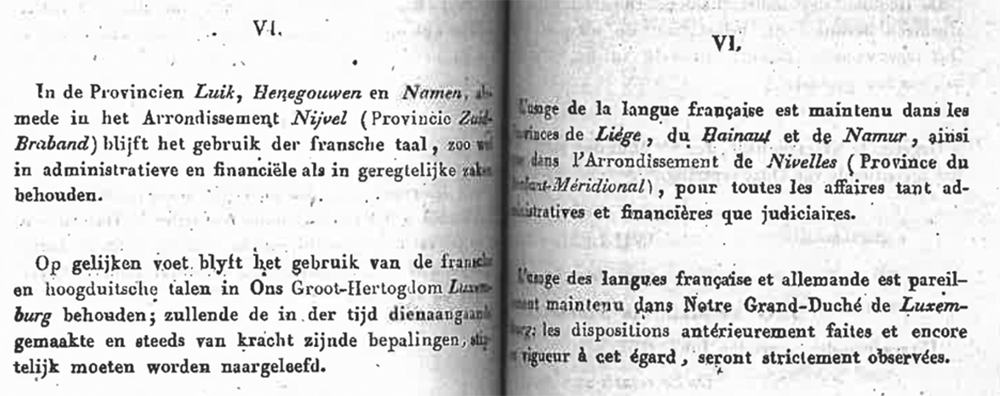
Figure 1. Article VI of the language decree of 1830 from the Journal Officiel du Royaume des Pays-Bas (http://data.legilux.public.lu/eli/etat/leg/argd/1830/06/04/n1/jo).
The second sentence of Article VI of the language decree states: “The use of the French and (High) German languages is equally maintained in Our Grand Duchy of Luxembourg; previously established arrangements still in force will be strictly applied in this respect.”Footnote 4 Interestingly, there is an explicit high/low register division in the Dutch version through the adjective hoogduitsche (High German) when referring to the German language, while no terminological distinction to refer to Standard German is made in the French version. Although langue allemande (German language) most certainly denotes Standard German, two distinct ethnometapragmatics are brought to the fore: one where the high/low register division is explicit and one where it is not. Three deictics stand out: the possessive adjective Ons/Notre (Our), and the temporal adverbs/adverbial phrases in der tijd/antérieurement (previously) and steeds/encore (still).
The deictic Ons/Notre is packed with indexical value because of not only its denotation but also its graphical representation. By indexing speaker origo, namely, the Dutch sovereign, one might interpret its denotation as collective ownership of a territory called the Grand Duchy of Luxembourg through the inclusion of the subjects (reader focus) of the sovereign. Yet, graphical representation comes into play through capitalization. The capitalization of the deictic makes the interpretation of the royal we more plausible: the pluralization of the Dutch sovereign as is customary among royalty, with capitalization here being iconic of status. Regarding the other two deictics, antérieurement/in der tijd (previously) and encore/steeds (still) establish a temporal connection that sources the current text to an unidentified previously existing policy text, such that continuity is presupposed (a cross-event linkage is thus already established). Indeed, there is a configuration of indexicals that link the linguistic signs named “French” and “(High) German” to a place named “Grand Duchy of Luxembourg” under the rule of the Dutch Crown.
The introduction to the legal text is enlightening because of its use of deictics, as shown in figure 2. The date of the text is stated, followed by a gerund construction (houdende/contenant ‘containing’) that establishes the topic of the decree (the diversity of languages in the kingdom). What proceeds is a declaration of the king: “We, William, by the grace of God, King of the Netherlands, Prince of Orange-Nassau, Grand Duke of Luxembourg, etc., etc., etc. [Being] Revised the decrees taken successively by Us on the subject of the various languages in use in Our Kingdom; wishing to provide the necessary modifications to these stipulations that can be desirable to bring ease to the residents; [having] consulted the Chiefs of the Ministerial Department and the State Council; have decreed and decree.” In both Dutch and French, the deictic royal we begins the ritual of passing legislation. The listing of titles indexes the authority and sempiternity of the king. The iterated abbreviation etc. presupposes a continuity of titles that are either known to all or unnecessary for the topic at hand. The king’s actions, embodied by the performative locutions at the end, are graced by the highest authority in that political system—God. The italicized form in graphical representation of this excerpt may index the importance of that particular passage. Passive voice construction pervades both versions of the text. As expected, there is verb agreement for first-person plural for the construction of the past tense:avons arrêté/hebben besloten, and for the present tense: arrêtons/besluiten (decree, decide), both being performative locutions.
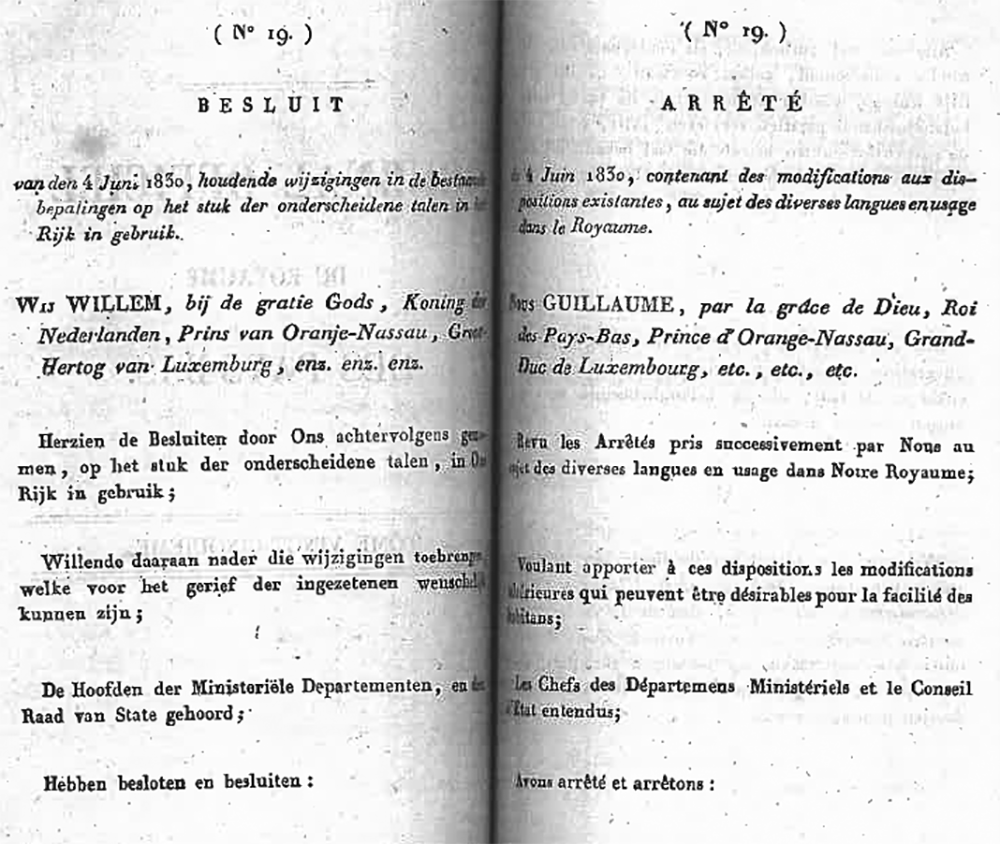
Figure 2. The introduction to the language decree of 1830 (http://data.legilux.public.lu/eli/etat/leg/argd/1830/06/04/n1/jo).
The copresence of the States (the political organization of the nobility and upper class that dealt with the affairs of state on behalf of the king) in the text is shown through a passive voice construction that frames the king as the sole origo. The participation framework consists of the king as speaker origo and the readers as focus, every word being binding for the subjects under Dutch rule, thus implicitly indexing other spatiotemporal settings (territories, time). This is a ritualized register that becomes an authoritative virtual model for every single moment of passing legislation. In other words, passing legislation was a genre requiring this register, the linguistic signs of its repertoire with their specific graphical representations. This can be further illustrated by dividing the different elements of the text into denotational, interactional, and graphical schemas.
Their text-level indexicality, or co-occurrence of signs (Reference AghaAgha 2007, 24), is configured in such a way that they have particular construals and effects mediated by ideology, as shown in table 1. The table follows Agha (Reference Agha2007, 47) in his division of denotational and interactional schemas, with the addition of a graphical schema to consider the salient differences of the written text. Nonitalicization of the written text is understood as the default. This virtual model is found in the following policy texts, where German takes the place of Dutch.
Table 1. Structure of the Introduction to the Language Decree of 1830
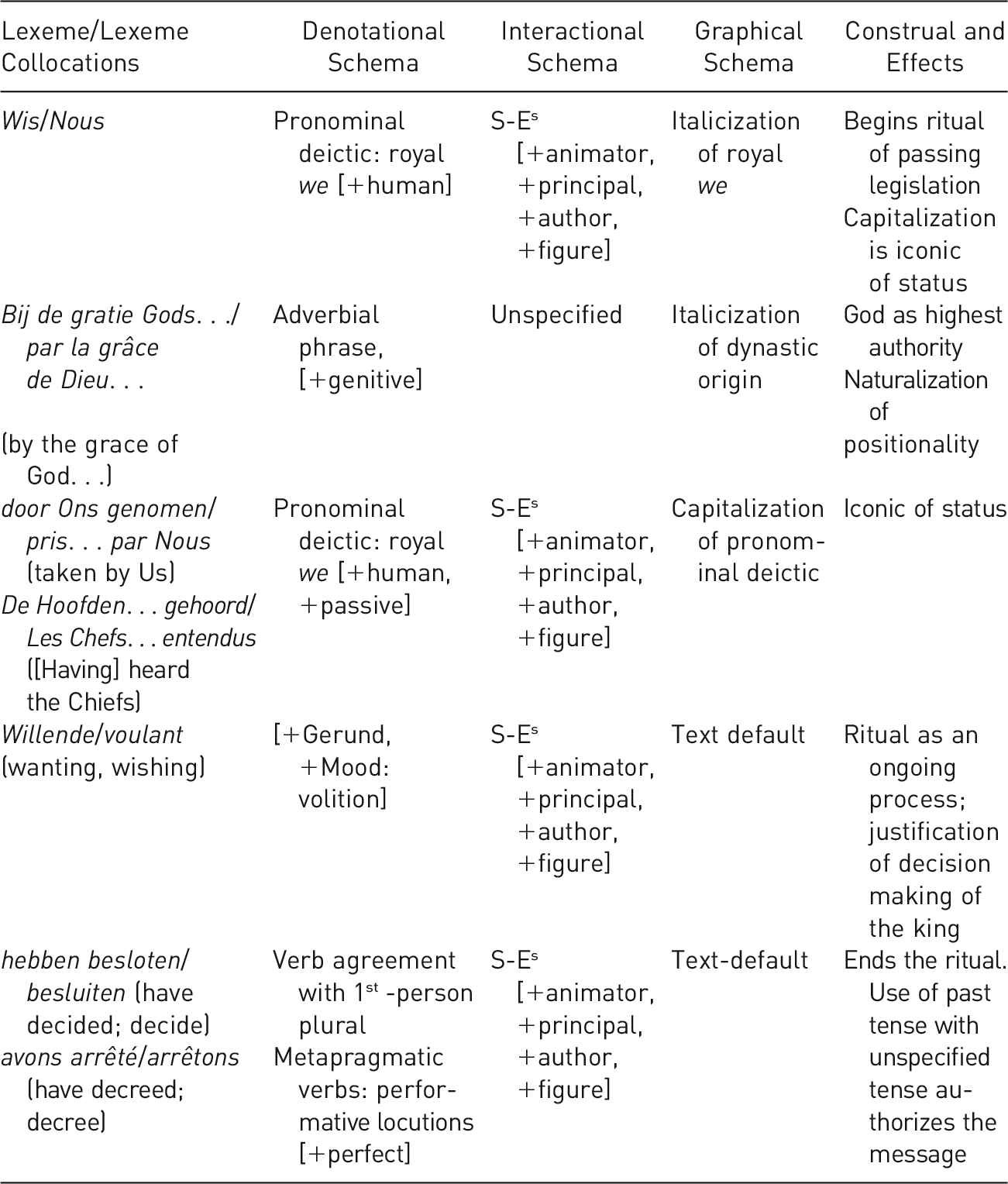
Note. S-Es = speaker of speech event; “+” is the specification of notional and grammatical categories.
Axes of Differentiation and Education Act of 1843
The Grand Duchy was, from 1815 to 1839, divided by a language border defined as, on the one hand, the quartier wallon in the west, and the quartier allemand in the east. The language border was determined by a so-called Romance-Germanic distinction (Reference FehlenFehlen 2011, 575), whereby the west was characterized by speakers of Walloon and varieties of French, whereas the east had a majority of speakers of what would become known as Luxembourgish. The establishment of borders in the aftermath of the Belgian revolution thus had an effect on language use: upon the recognition of Belgian independence in 1839, the western part (quartier wallon) was conceded to the Belgian state, which left a majority of speakers of the Luxembourgish Germanic variety in the eastern part, what is today Luxembourg. The city of Luxembourg became the center in a spatial configuration divided by an axis of urban/rural differentiation (table 2).Footnote 5 The values of the axis change according to the ideological differences between social domains, as will be shown below.
Table 2. Axis of Urban/Rural Differentiation
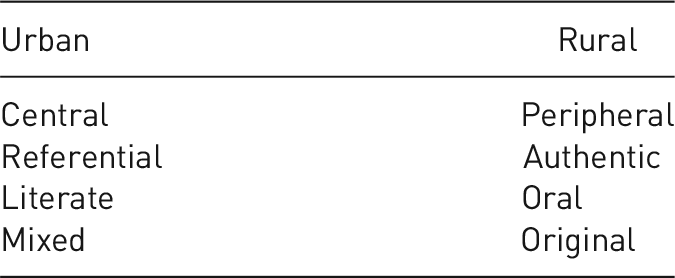
In 1841, the Dutch Crown, now held by William II after William I’s abdication in 1840, conceded some degree of autonomy to the Grand Duchy. The population was thus confronted with the need to create its own state apparatus and infrastructure (Péporté et al. Reference Péporté2010, 115; Reference PaulyPauly 2013, 69–70), despite the continued personal union with the Dutch monarch. One of the most important results of this autonomy is the Education Act of 1843, which institutionalized the teaching of French alongside German in the primary school system, as shown in figure 3. The first article of the act states: “Primary education necessarily comprises: religious and moral education, reading and writing in German and French, the rudiments of both languages, and arithmetic.” A clearly nomic pattern makes it a universalizing claim.Footnote 6
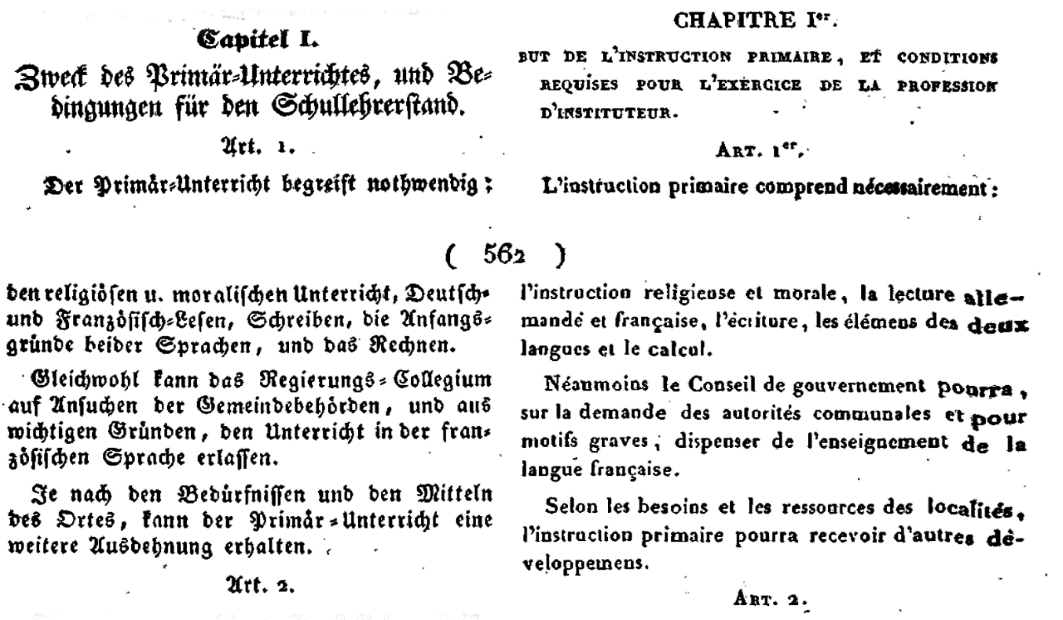
Figure 3. First article of the Education Act of 1843 (Mémorial législatif et administratif du Grand-Duché du Luxembourg, Loi du 26 juillet 1843 sur l’instruction primaire; https://legilux.public.lu/eli/etat/leg/loi/1843/07/26/n1/jo).
As shown in figure 4, the speaker origo is the Dutch king and grand duke, William II, with the copresence of the States of Luxembourg: “We, William II, by the grace of God, King of the Netherlands, Prince of Orange-Nassau, Grand Duke of Luxembourg, etc., etc., etc., wishing to provide for the needs of primary education in Our Grand Duchy of Luxembourg, and to ensure its progress; after consultation and with the approval of the States of Our Grand Duchy; have decreed and decree the following …” This is the exact register that appears in the language decree of 1830, with the difference that German, instead of Dutch, is the other language used in this text.Footnote 7 Italicization of the royal titles is avoided as well. Moreover, the Fraktur script indexes graphically the difference of linguistic signs grouped under “German.” However, there are differences in the gerund construction expressing intentionality through a modal verb. Since the gerund construction is infelicitous in Standard German, the adverbial phrase conveying intentionality, In der Absicht (with the intention of), is used. This is due to differences of language use that will not be addressed here. Nevertheless, they have isopragmatic effects (they have the same effect when read), making them (fractionally) congruent in terms of indexical value. They share a “metrical” structure based on text position: royal we, reasoning/justification of king’s intentions, copresence of the States (which indexes a particular political system in a specific spatiotemporal setting, just like the text itself), performative locution, and a participation framework (king as origo, subjects as focus).
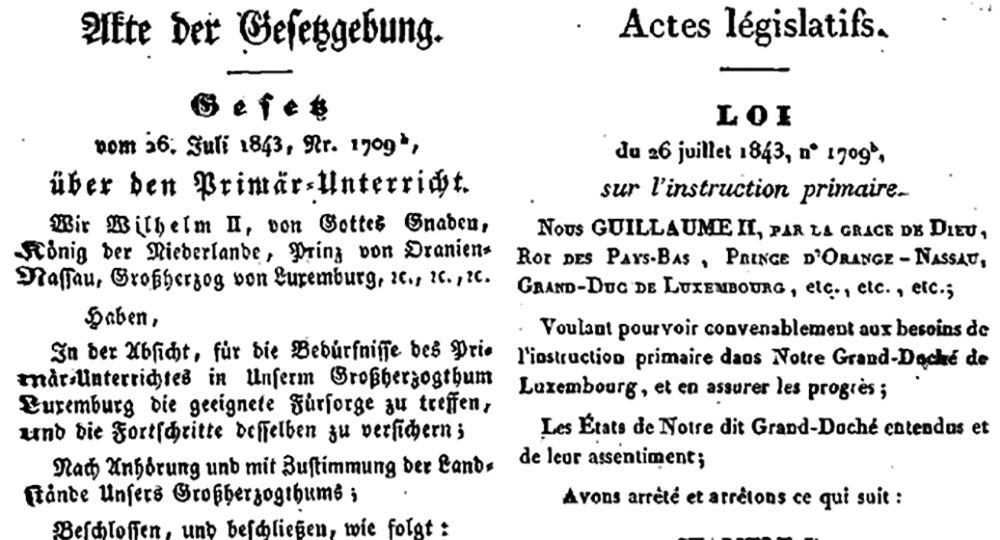
Figure 4. Introduction to the Education Act of 1843 (https://legilux.public.lu/eli/etat/leg/loi/1843/07/26/n1/jo).
Sociohistorical reasons have been attributed to the emergence of the bilingual policy of the Education Act of 1843, such as the fact that French became a chancery language of Luxembourg in the fourteenth century (Reference StellStell 2006, 24). Another reason alluded to is the integration of Luxembourg to the French Republic from 1795 to 1814, which supposedly consolidated the place of French in administrative affairs among the Bildungsbürger (educated state officials) and Notabeln (distinguished upper class) (Reference FehlenFehlen 2018, 58). But we can only talk about the supposed continuity of French as an administrative language in Luxembourg if “French” and “Luxembourg” are regarded as immutable, transhistorical objects. That is already ideological work establishing temporal connections.
Furthermore, sociohistorical reasons do not suffice to explain the emergence of this bilingual language-in-education policy. If regarded as metapragmatic discourse, the bilingual policy is not only a prescriptive measure but also a typifying one. It is a metapragmatic typification of the use of French and German in a “nascent” institutional context, namely, the school, through a nomic pattern. The Education Act established a normative standard for schooling. Although French was already a strategic emblem of personhood among an elite social domain, this emblem of personhood turned into a strategic emblem of nationhood throughout the nineteenth century under contrastive schemes of value, as we will see below. It resembled walking a tightrope, as German was also a strategic emblem of personhood (Reference StellStell 2006, 25). However, the justification provided by the political actors for the mandatory inclusion of French only highlights socioeconomic aspects. According to Thyssen (Reference Thyssen2013, 16): “This amendment was introduced by the States’ central section and reportedly inspired both by the ‘frequent relations with France’ and ‘a philanthropic sentiment’ towards labourers, who generally found more advantages in Belgium and France than in Germany.” In this passage, the center is indexical of the capital of the country, where there was a will for exerting political power resembling Jacobin measures of centralization (Reference StellStell 2006, 14; Reference FehlenFehlen 2018, 64, 66, 72). Those who could hold political power came from a privileged socioeconomic background, where French was the language of usage in matters of “high culture” and administrative affairs. This was sustained by census suffrage, in which a man was allowed to vote according to a tax revenue threshold (Reference PaulyPauly 2013, 73; Reference FranzFranz 2015, 278–79). Census suffrage excluded the majority of denizens and allowed a privileged socioeconomic minority to hold political power while under the rule of the Dutch monarch.
The mandatory teaching of French was met with resistance from teachers and parents, sometimes leading to boycotts as well as calls for the elimination of the French course (Reference FehlenFehlen 2013a, 92), even though the policy of teaching French was not broadly implemented in school. The reasons for this were primarily material: lack of infrastructure for the teaching of French in school (Reference FehlenFehlen 2013a, 77) and, more importantly, schooling became compulsory only in 1881, almost 40 years later (Reference PaulyPauly 2013, 70; Reference FehlenFehlen 2018, 64). This lack of implementation is foreshadowed by the second sentence of Article 1 of the Education Act: “However, the Government Council can, at the behest of the municipal authorities and under grave circumstances, exempt the teaching of French.”
Despite the lack of implementation of the French course, the resistance to it led to ideological polarization, which led to multiple axes of differentiation. The anchors of such axes were urban versus rural, German versus French (character), and elite versus common. These anchors became more prominent in the second half of the nineteenth century. Polarization became more salient, since the majority of the population did not speak French (Reference FehlenFehlen 2013a, 80–81; Reference Fehlen2018, 65).
Circulating Metapragmatic Discourses
Added to this polarization was the effect of the territorial division of 1839, which contributed to the emboldening of discourses linking the Luxembourgish language to a German national identity. A high/low register division (High German versus varieties subsumed under “German”) allowed for the enregisterment of a Luxembourgish voice that was inherently “German.” As such, the presence of French among various social domains in the grand duchy was deemed corrupting of the German character of the “Luxembourger.” These discourses became prominent in the 1840s and 1850s among intellectual circles and the nascent media. Other discourses showing a different value scheme were circulating around the same time: they linked French to a Luxembourgish character and thus enregistered a Luxembourgish voice as bilingual (since Luxembourgish was still subsumed under “German”). Continuity among these discourses existed until the beginning of World War I as two pathways characterized by distinct ethnometapragmatics solidified.
A prominent example of a discourse that made French an emblem of the Luxembourger is found in a publication by Michel-Nicolas Muller, director of the Atheneum in Luxembourg (an elite institution for secondary education) from 1821 to 1866 (Reference FehlenFehlen 2018, 63). Muller wrote a report (Reference Muller1844) on Luxembourg’s nascent language-in-education policy in the Courrier du Grand-Duché du Luxembourg, a French-language newspaper that ran from 1844 to 1888. The aim of the report is to disqualify German and French handbooks for the teaching of French in Luxembourg. For this purpose, Muller describes the “ethnographic position” of the country, as shown in figure 5:
Bordering France and Belgium and having, for centuries, continuous ties with these two countries, Luxembourg does not find itself in the same position as the populations of the interior of Germany. Concerning language, [Luxembourg] has traditions, different habits and interests. Since time immemorial, the French language has been among us the language of conversation in high society, it has been and is still the organ of the general administration, the language of most social transactions and, ever since Luxembourg has a secondary school [collège], that is, more than two centuries, it has been, next to Latin, the vehicle of higher education.
In the very first sentence, a contrast is established between Luxembourg and Germany. Spatial and temporal indexicalities are established by the use of the adjective limitrophe (bordering) and the adverbial phrase depuis des siècles (for centuries). Through a configuration of typifying indexicals, France and Belgium are presupposed as francophone spaces, of which the geographic and historical proximity justifies the differentiated positionality of Luxembourg vis-à-vis Germany, phrased metonymically as the whole encompassing the parts (its speakers). The second and third sentences continue this line of reasoning. The second sentence follows the pattern of nomic truths, as the noun phrases and verbs are unspecified.
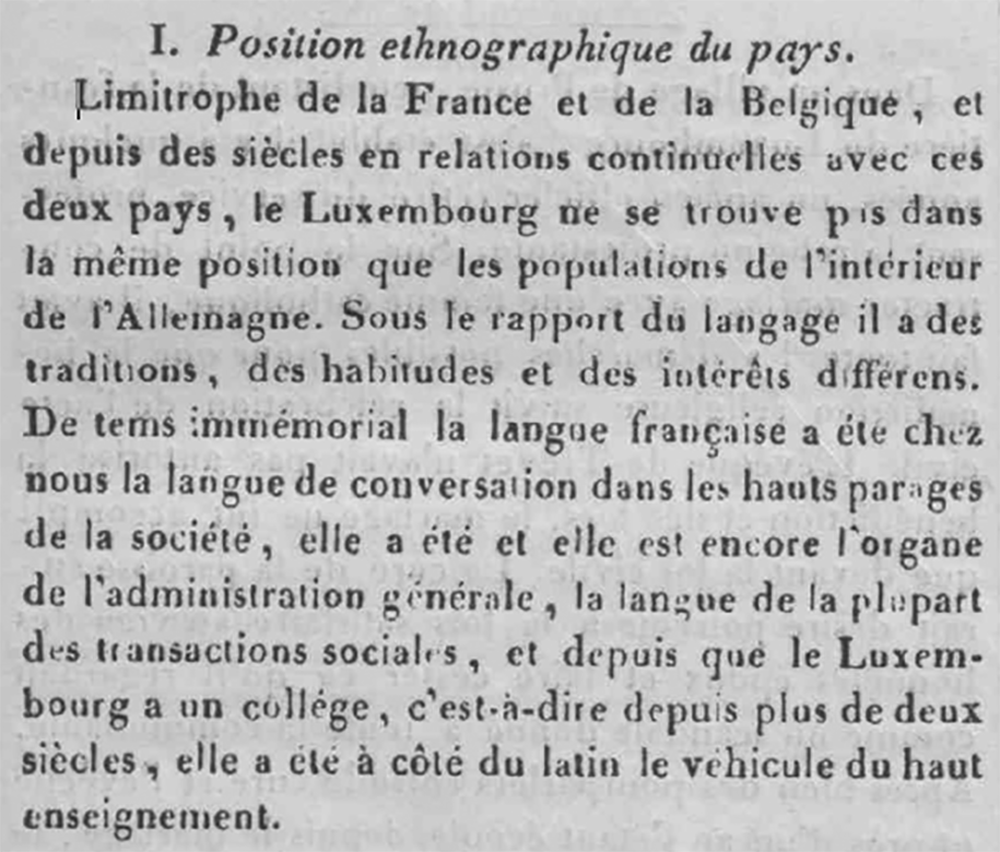
Figure 5. Extract from the report written by Michel-Nicolas Muller and published in the Courrier du Grand-Duché du Luxembourg on August 24, 1844.
The third sentence begins with the adverbial phrase de temps immémoriel (since time immemorial), naturalizing the existence of French, deictically situating it in Luxembourg by the other adverbial phrase chez nous (among us), the nous being a pronominal deictic that positions the reporter (Muller) as pertaining to the class Luxembourger (group allegiance). A metapragmatic discourse follows, in which the use of French in different contexts is described, such contexts being not only matters of state but also day-to-day interactions. It is thus a description of the social range of French as a register—an exquisitely explicit metapragmatic discourse. In the end, it is equated to Latin in terms of the register repertoire and social range, cementing French in social ranges of high culture. A brief sketch of the narrating and narrated events is presented in figure 6. Following Wortham and Reyes (Reference Wortham2020), Muller’s text is reported speech characterized by many deictics and evaluative indexicals.
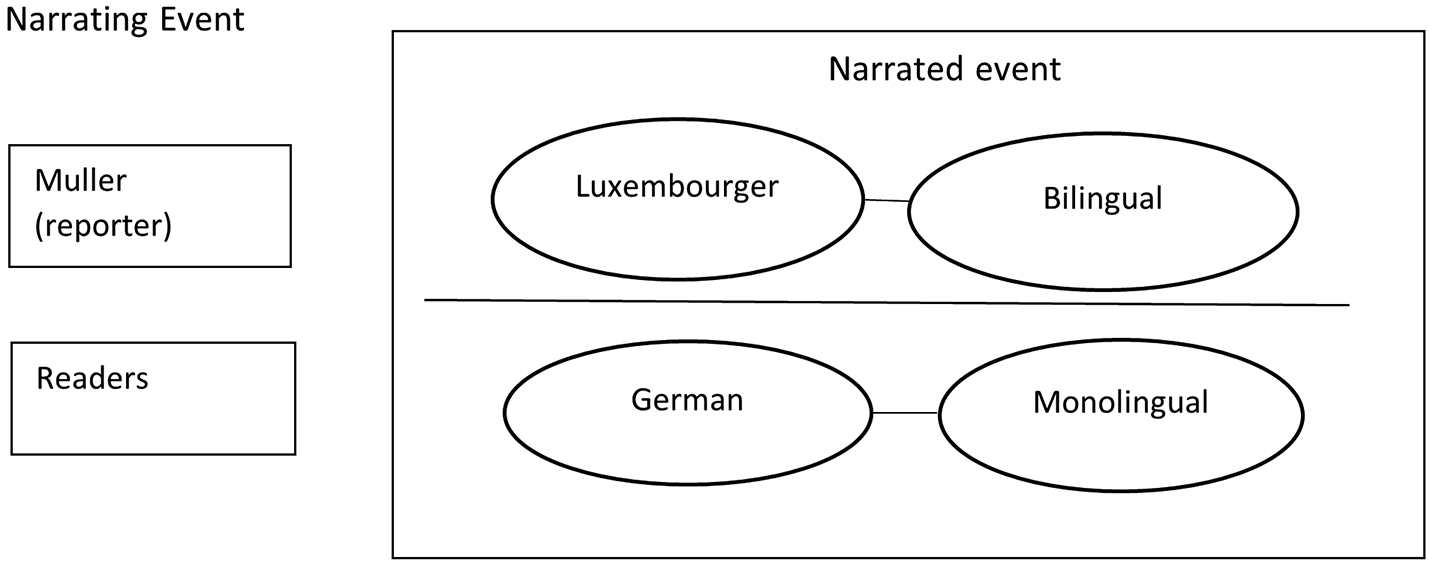
Figure 6. Sketch of the narrating and narrated events following Wortham and Reyes (Reference Wortham2020)
In the second section of the same text (not illustrated here), the population of Luxembourg is described as “bilingual” (bilinguique in the original), an argument deeming the use of German grammar books inappropriate in Luxembourg. However, in the third section of the text (fig. 7), it is not German the language mentioned in addition to French, but Luxembourgish. It is a very brief but powerfully descriptive mention of the language: stating that the grammar books might be useful for people of Swabia and Pomerania, who are not confronted with French on a daily basis, Muller goes on to propose that students in Luxembourg must learn good French pronunciation from their teachers’ utterances, not from books. But, according to him, the students are aided in their learning of good pronunciation by the “soft suppleness” (molle souplesse) of the “Luxembourgish idiom” (idiôme luxembourgeois).Footnote 8
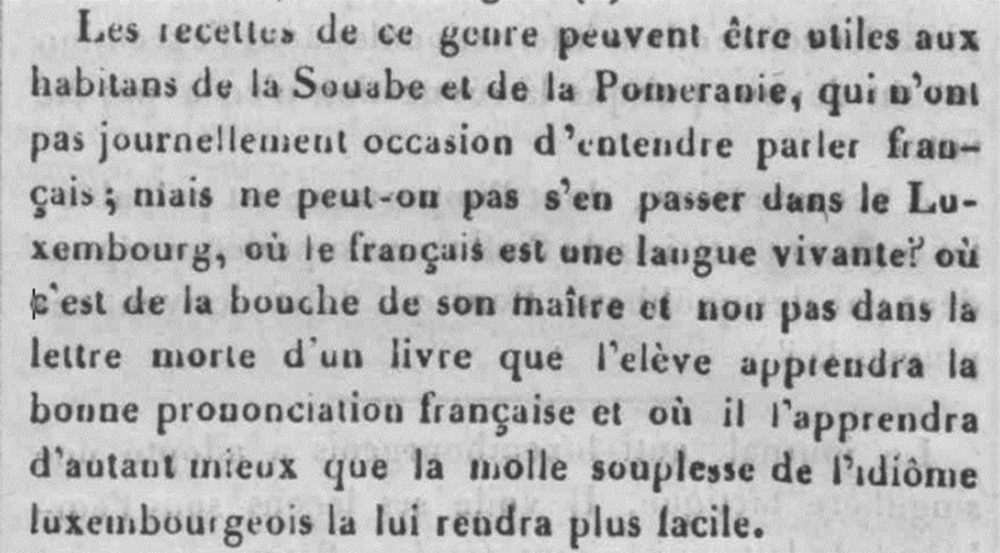
Figure 7. Third section of Muller’s text in the Courrier du Grand-Duché du Luxembourg
This is a reanalysis whereby sounds grouped as linguistic signs are attributed qualities, or “qualia” (Reference GalGal 2013, 33). In this case, “soft” and “flexible” are attributed to Luxembourgish through rhematization: sounds-as-linguistic-signs that pertain to the register repertoire indexical of social personae (Luxembourger) are interpreted as having a likeness (iconic value) with a sensuous quality. In Muller’s text, this relation is implicitly recognized for French as well. According to Muller, the shared qualities “simplify” the learning of French for Luxembourgers. An implicit contrast is established: on the one hand, French and Luxembourgish and, on the other hand, German varieties. Muller’s discourse is an ethnometapragmatics that presupposes bilingualism as an emblem of personhood of the Luxembourger.
Ethnometapragmatics of Luxembourgish as a Discursive Register
While French and German were being enregistered at various scales through policy and media (becoming objects of contrastive value schemes in different social domains), discourses about Luxembourgish and literary production in Luxembourgish were circulating at the same time in the social domain of intellectual circles (such as the so-called société de gymnastique). These discourses were overlapping, not separated from each other in static social categories and spaces. In other words, Luxembourgish was always put in relation to German or French, with the ensuing enregisterment of Luxembourgish based on distinct predicates in relation to the two other registers, which led to differing ethnometapragmatics.
Two historical figures whose respective work about Luxembourgish displays contrasting ethnometapragmatics are Jean-François Gangler and Peter Klein. Gangler wrote the Lexikon der Luxemburger Umgangssprache (Lexicon of the Luxembourgish vernacular), published in 1847, and Klein wrote Die Sprache der Luxemburger (The Luxembourgers’ language). The titles are already full of indexical value; Umgangssprache implies a register hierarchy between activities: writing and speaking. Different registers are deemed appropriate in writing and speaking, these being High German and French, on the one hand, and Luxembourgish, on the other hand. The Sprache der Luxemburger links identified speech forms grouped under “language” with a type, a social persona named “Luxembourger.” Despite these titular differences, Luxembourgish is enregistered as a dialect of German in both works.
Klein and Gangler both establish links between linguistic and nonlinguistic signs to justify a high/low register division between Luxembourgish (low) and German and French (high). A history of the people inhabiting Luxembourg is coupled with a history of German as a cluster of dialects. The use of Mundart (a term referring to dialects) indexes such a relationship in their work. Yet they diverge in their understanding of a Luxembourgish voice, based on differing ideologies of nationhood. While for Klein, the Luxembourger has been “distanced” from his German character by Franzosentum, or French character (Reference KleinKlein 1855, iv), Gangler makes no such claims of the corrupting nature of French in relation to the Luxembourgish voice. The difference between them lies in their understanding of Franzosentum in relation to a Luxembourgish “character,” the reanalysis of which results in contrasting ethnometapragmatics about Luxembourgish.
Gangler seems to allow both German and French as “high registers,” coupled with a lamentation of the inability of Luxembourgish to “rise up” (Reference GanglerGangler 1847, foreword). Mentioning the inclusion of French loanwords in the dictionary, Gangler wittily plays with the indexical values and enregisters in such a way the Luxembourger: “Endlich findet darin Platz die Menge französischer Wörter, welche im Luxemburger Dialect das Bürgerrecht erhalten haben, und für welche der Luxemburger pur sang sich nie des entsprechenden deutschen Wortes bedient” (Reference Gangler1847, foreword, emphasis added).Footnote 9 Gangler voices the Luxembourger through the phrase pur sang, which has an emblematic effect in the excerpt.
A complaint about the gradual disappearance of the Eigenthümlichkeiten (particularities, uniqueness) of the language is expressed with defeat, due not only to French but also to “New High German” (Reference KleinKlein 1855, 6). An ancestral character is attributed to lexemes of Luxembourgish, linking them to rurality as their only refuge, while the variety spoken in the capital is pitied as the victim of foreign influences that extinguish the real Luxembourgish character of the Mundart (Reference KleinKlein 1855, 6).Footnote 10 Interestingly, the first chapter, titled “Wesen unseres idioms” (The essence of our idiom),Footnote 11 briefly goes against a comparison between Dutch and Luxembourgish as an argument against considering Luxembourgish “its own language” (Reference KleinKlein 1855, 9). The underlying assumption is that Dutch developed out of a German dialect. This comparison is addressed in detail in the last chapter, titled “Zukunft der mundart” (The future of the Mundart) (Reference KleinKlein 1855, 91). The argument is based on a clear high/low register division diagrammatically represented by a division of a written register and a spoken register. While Dutch was able to develop literature (epics, poetry, and drama are given as examples), Luxembourgish did not and is deemed unable to do so due to the small size of Luxembourg and to the strength of the surrounding languages.
Klein’s book circulated widely among intellectual circles and influenced similar discourses until the beginning of World War I (Reference HermanHerman 2003, 8). As such, the book became a “baptismal site” (Reference SilversteinSilverstein 2005), that is, a retrospectively authoritative moment that marks the beginning of a semiotic chain constituting a pathway. These discourses described lexemic and grammatical aspects of Luxembourgish with a criticism against gallicization. An exhaustive account of the circulation of these discourses can be found in Herman (Reference Herman2003).
The Constitution of 1848
In the following years, the revolutionary specter haunting Europe also reached Luxembourg, mainly due to socioeconomic reasons (Reference PaulyPauly 2013, 72–73). King William II, under the pressure of these revolutionary waves, was forced to certain concessions resulting in 1848 in an amended constitution that guaranteed freedom of the press, freedom of speech, and freedom of assembly. Census suffrage was kept, but the census was decreased, thus allowing for a quarter of male citizenry to participate (Reference FranzFranz 2015, 278–79). However, most relevant here is Article 30 of the Constitution (fig. 8), which states: “Everyone is free to use the German language and the French language; the use of either language cannot be restricted.” It follows a nomic pattern, does not specify spatiotemporal connections, and is characterized by nominalization and passive voice.

Figure 8. Article 30 of the 1848 Constitution of the Grand Duchy of Luxembourg (Mémorial législatif et administratif du Grand-Duché du Luxembourg, Constitution du 9 juillet 1848 du Grand-Duché de Luxembourg; http://data.legilux.public.lu/eli/etat/leg/ordr/1848/07/09/n1/jo).
The Constitution of 1848 consolidated the bilingual personal policy of Luxembourg. By declaring in the Constitution that “everyone is free to use the German language and the French language; the use of either language cannot be restricted,” the high/low register division was institutionalized, with the erasure of Luxembourgish being entailed by the presuppositions of the two ethnotapragmatics in play. The proposition is a baptismal site that not only authorizes the use of two discursive registers, but also makes their prohibition explicitly impossible. As a baptismal site, it heralds (Gal and Reference GalIrvine 2019, 200) the division of linguistic labor for future metapragmatic regimentation. Through their institutionalization, connections were established in policy as a site of ideological work with other sites, that is, public institutions and the school system.
The article in the Constitution as metapragmatic discourse typified French and German. In other words, it presupposed the existence of French and German as clearly defined registers with their particular instances of use. Their typification as languages also established temporal connections through sourcing, as the two languages were now institutionally enmeshed in an interdiscursive web that presupposed historical continuity. Furthermore, this entailed not only the enregisterment of French and German as standards but also the erasure of any other possible discursive register in the organization of public institutions. The two registers’ social range and social domain(s) are represented in table 3.
Table 3. French and German as Registers: Social Range and Social Domain
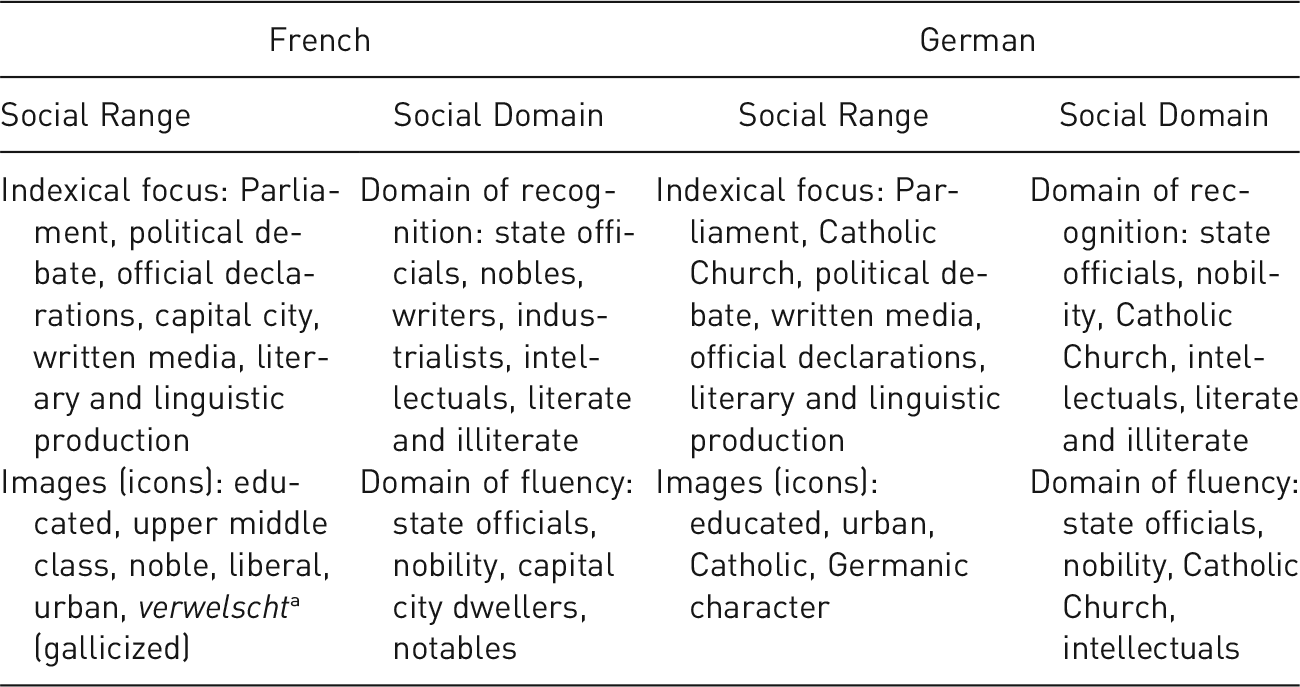
a Welsch was a term denoting Latin societies in a division between “Germania” and “Romania” in Europe. The term was used in the German-speaking areas of Europe.
Throughout this period, two apparently solidified pathways had developed across speech events forming two ethnometapragmatics:
-
1) an enregisterment of the Luxembourger whereby French and German (with Luxembourgish subsumed under it in a high/low register division) became emblems of personhood in elite social domains, and lexemes of French origin in the Luxembourgish language became iconic of a Luxembourgish voice;
-
2) an enregisterment of the Luxembourger as gallicized German (verwelscht).
In semiotic terms, competing ideologies of nationhood led to a rhematization of the Luxembourger: the overlapping repertoires of the discursive registers with indexical value became iconic as supposed inherent qualities of the Luxembourger. Plainly: having French loanwords in Luxembourgish coupled with the presence of French in contexts such as Parliament indexed either a corrupted, gallicized German figure particular to Luxembourg or a bilingual Luxembourgish figure, both having contrasting attributes that became iconic of the figures, yielding two distinct emblems of personhood (illustrated in table 4). These two pathways overlapped in 1896, when a shift occurred in the Chamber of Deputies (see below).
Table 4. Two Emblems of Personhood in Nineteenth-Century Luxembourg

Spoo’s Speech of 1896
The death of William II in 1849 coincided with the restorationist backlash of the German Confederation. He was succeeded by his son, William III, who rolled back the liberal Constitution of 1848 by reinstating a constitution in 1856 that guaranteed almost absolute powers to the Dutch Crown. The Constitution mainly corresponded to the restorationist principles of the German Confederation, since Luxembourg was a member of it. This meant that all the aforementioned civil freedoms and parliamentary powers were drastically restricted. This was reversed in 1868, when a liberal constitution was reinstated through amendments.
Socioeconomic and political changes of the end of the 1880s and the 1890s led to the emergence of, on the one hand, working classes and middle classes and, on the other hand, of new political members. The socioeconomic changes were mainly due to the exploitation of iron ore and the expansion of state services. The main political change was the reduction of the census in 1892, which allowed for “greater” political participation and the inclusion of alternative members in a Chamber of Deputies dominated by industrialists and notables. Caspar Mathias Spoo, elected in 1896, would contribute to the enregisterment of Luxembourgish by troping upon the norms of Parliament through the use of Luxembourgish. Spoo’s speech is itself a metasemiotic typification through a reanalysis of Luxembourgish as a metasign. I will only briefly sketch the most important aspects of the speech, since a comprehensive analysis of it requires an entire article.
The Chamber of Deputies in Luxembourg consisted of a participation framework in which the choice of a language was a speaker-focal demeanor indexical (Reference AghaAgha 2007, 315). By the institutionalization of the two discursive registers—High German and French—their use was made presupposable by the high/low register division that underlay the two pathways described above. Thus, the use of Luxembourgish troped upon the established norm. Following a first speech in Luxembourgish on November 10, 1896, after taking the oath of office as deputy, Spoo gave another speech in Luxembourgish, on December 9, 1896, pleading for the language’s use in Parliament. As shown in figure 9, the speech begins with Dir Hèren (You sirs), two deictics, a second-person plural and a noun establishing gendered speaker focus. It is immediately interrupted by the president of the Parliament.
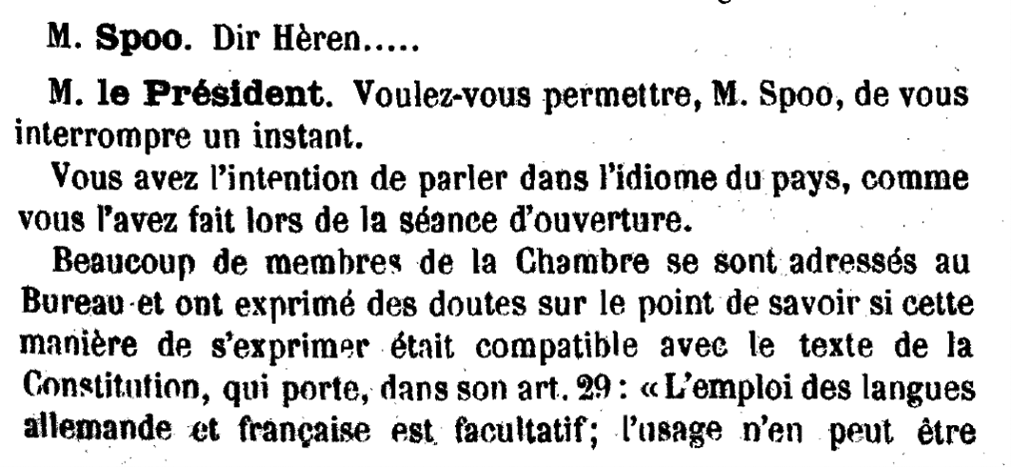
Figure 9. Extract of parliamentary debate of December 9, 1896, from Fehlen (Reference Fehlen2013b)
The interruption is in French, one of the registers institutionalized. The president of the Parliament reports that many members of the Chamber asked whether the use of Luxembourgish was compatible with Article 29 (the Constitution was amended in 1868, so the number of the article of the 1848 Constitution changed with the amendments) institutionalizing the use of German and French. He further reports: “Beaucoup de ces hon. membres ont exprimé l’opinion que l’art. 29 de la Constitution, en parlant de la langue allemande, parle de la langue allemande proprement dite, et non pas d’un idiome, d’une espèce de patois.”Footnote 12 (Reference FehlenFehlen 2013b). The high/low register division is explicitly referred to in this metapragmatic discourse.
The president of the Parliament proceeds with a comparison of the high/low register division in the surrounding countries as a justification for the erasure of Luxembourgish in Parliament. Speech forms are grouped under names of geographic origin (Bas-Breton, Marseillais, Gascon, Colonais, Platt). After various deliberations by deputies, Spoo gives a speech in Luxembourgish that tropes upon the high/low register division by describing Luxembourgish as German, but as an older, more honorable language than High German. In his speech, the underlying assumption that written language equals high register and spoken language equals a low register is reversed. But an “elevation” of Luxembourgish is also sought after by alluding to a nascent literary canon in the Luxembourgish language.
Furthermore, Luxembourgish is called upon as a public language that could include every citizen of the grand duchy in a democratic public sphere. Mediated by an ideology of democratization, Spoo’s speech enregisters Luxembourgish as an emblem of nationhoodFootnote 13 (fig. 10). The response to the speech consists of various declarations that provide arguments for the inappropriateness of Luxembourgish in Parliament: the variation of the language according to geographic differences (“dialectal” differences) and the naturalization of bilingualism as a bulwark against the nationalization of Luxembourgish (fig. 11). Spoo’s speech had a resounding effect in the media, sometimes being considered the event that led to the inclusion of Luxembourgish in the school system as part of the educational reform of 1912 (Reference FehlenFehlen 2013b). Although it was indeed a shift in ethnometapragmatics, it was a slight shift that is exemplary of fractal recursivity.
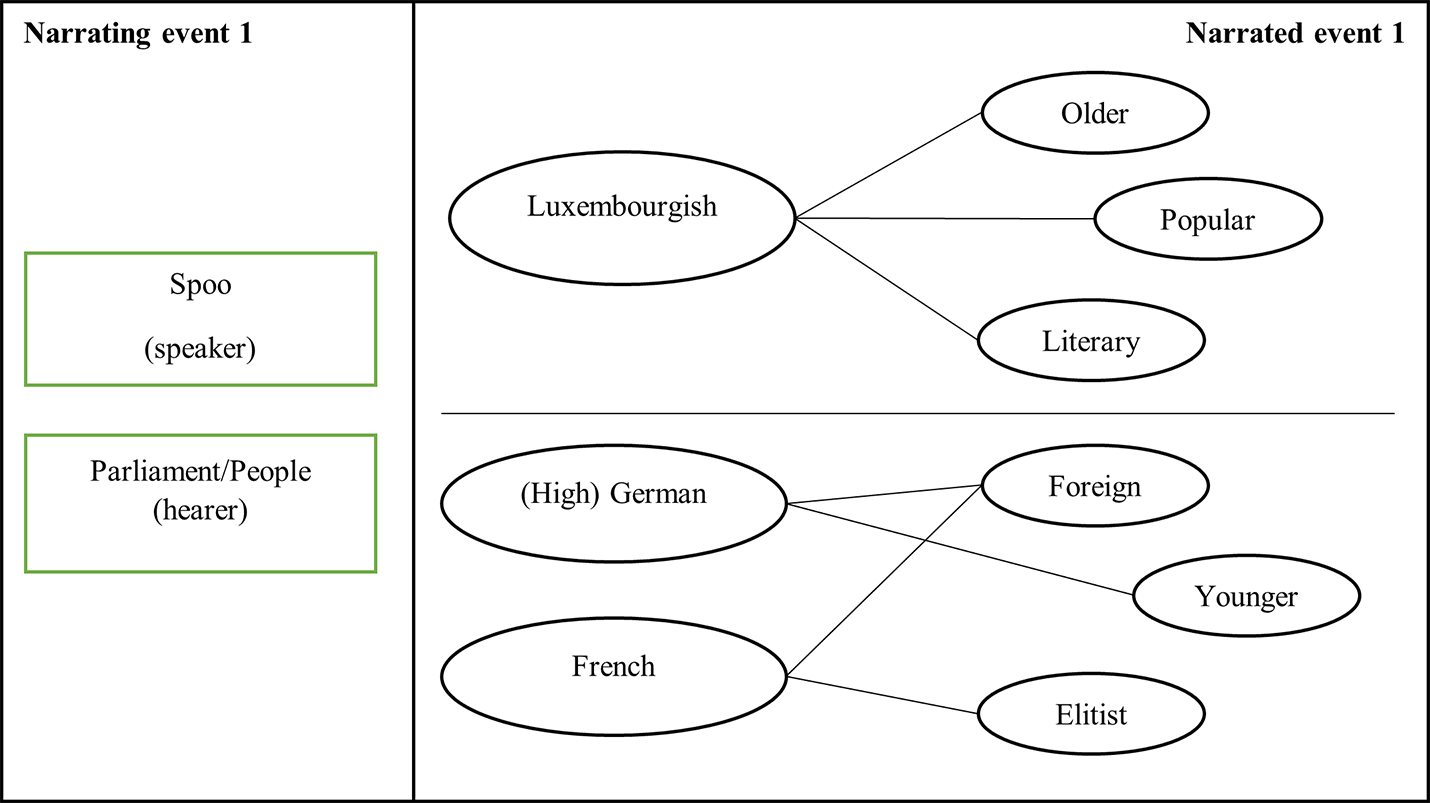
Figure 10. Spoo’s speech: Narrated and narrating event 1
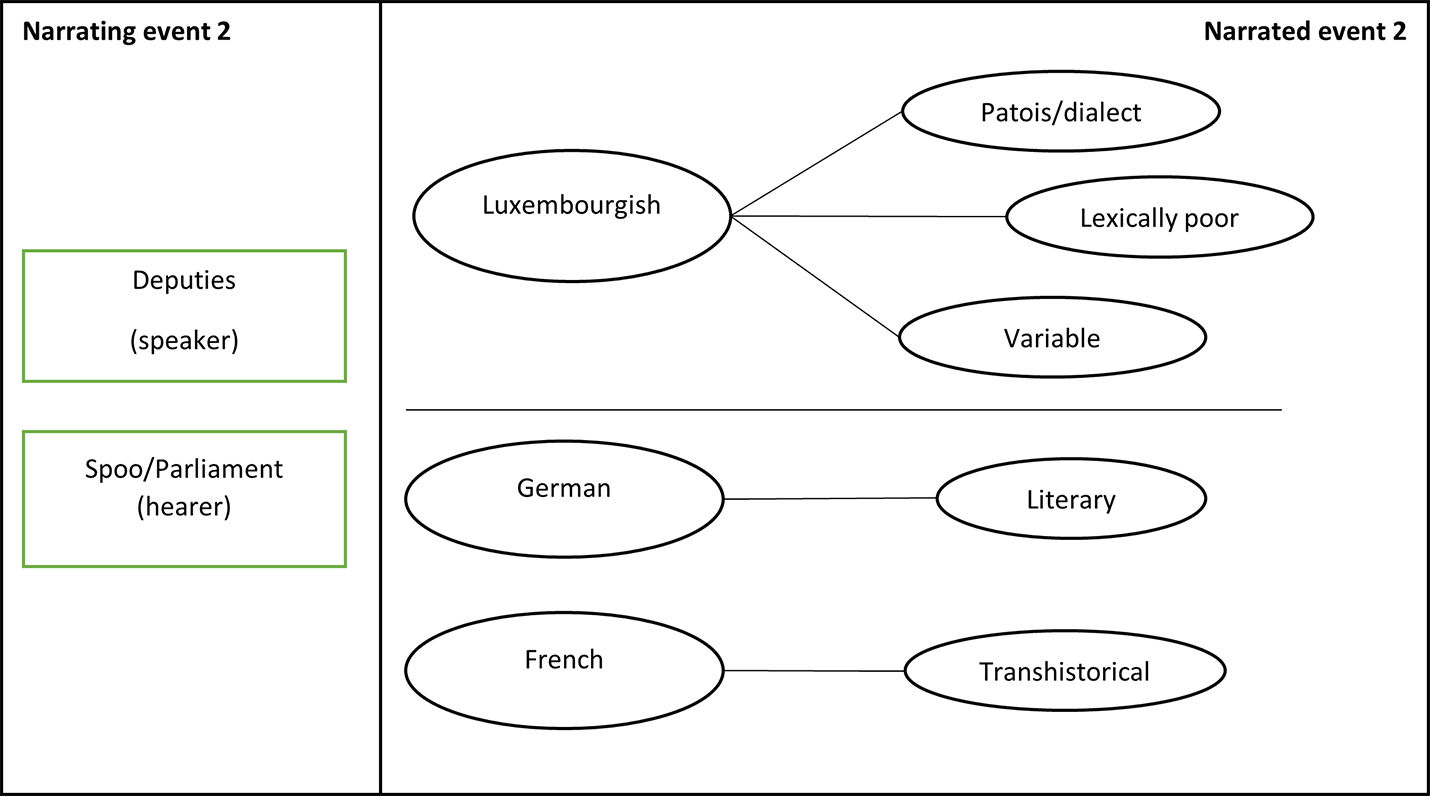
Figure 11. Response to Spoo’s speech
Conclusion
Following a linguistic anthropological approach, this article has delved into the enregisterment processes of nineteenth-century Luxembourg through the analysis of policy, newspaper, and linguistics texts. The analysis shows that heterogenous discourses competed for the enregisterment of three linguistic varieties: French, German, and Luxembourgish. The positionality of the speakers and the ideologies of nationhood led to differing enregisterments in the analyzed texts. The social and political organization of the first half of the nineteenth century entailed the use of French and German, enregistered as standard languages, with Luxembourgish presupposed as a low register of German. The two standards were emblems that, upon instantiation, pointed to the social position of the speaker in a system characterized by a division of linguistic labor. Social and political inequality (made manifest in census suffrage) accentuated this first-order indexicality. Political and social hierarchy was indexed by the use of French and German in specific presupposed contexts. Their institutionalization also entailed a second-order indexicality, a tropic use of both languages as not only a political balancing act but also as an expression of group allegiance or rejection mediated by conflicting ideologies of nationhood.
These processes of enregisterment are illustrated by discourses found in the policy texts of the newly formed Luxembourgish state through the declaration of German and French as the languages of the state. Because of the high/low register division, Luxembourgish was not taken into account in policy texts in nineteenth-century Luxembourg. However, certain newspaper articles and, particularly, linguistics texts, contributed to the enregisterment of Luxembourgish as a German dialect (as illustrated by Klein and Gangler’s texts), with differing positions emerging according to the ideologies of nationhood that shaped the authors’ discourses.
Some might say that the ethnometapragmatics undergirding this division of linguistic labor was mediated by the predominant ideology of standardization of post-Enlightenment nation-building. Gal (Reference Gal2018, 229) has called this the “axis of modernity” due to its prevalence in most European nation-states during the historical period of “modernity.” In such an axis, language is divided into standard versus nonstandard/dialect/indigenous/minority language, with contrasting sets of properties. To name but a few: standard has qualities of anonymity, universality, progress, center; while nonstandard has qualities of authenticity, particularity, tradition, periphery.
The ethnometapragmatics of Luxembourg throughout the nineteenth century show a more complex picture than the axis of modernity, based on conflicting valorizations of the enregistered languages (French, German, and Luxembourgish), mediated by ideologies of nationhood. Because of fractal recursivity (Gal and Reference GalIrvine 2000, Reference Gal2019), enregisterment processes can affect other linguistic signs according to the frame of reference. Thus, discourses favorable to the presence of French in Luxembourg linked lexemes of French origin in Luxembourgish to an authentic Luxembourgish persona, while discourses that enregistered German as the language of the Luxembourger linked the use of French lexemes in Luxembourgish to a corrupted, gallicized social persona whose core is originally Germanic. Therefore, Luxembourgish was indeed metasemiotically typified as “nonstandard,” but the object-signs linked to the nonstandard varied according to the positionality of the person and the conflicting ideologies of nationhood. Despite the slight shift in the two pathways effected by Spoo’s speech, René Engelmann’s work in the early twentieth century and World War II were the decisive events in the shift of pathways and thus in the enregisterment of Luxembourgish. I will delve into this in another article.
















